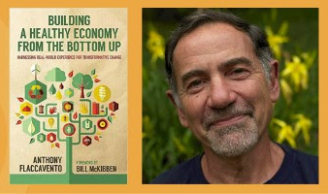Walden, Found
Last month, I traveled up to Burlington, Vermont, where I had previously lived for two semesters while attending Burlington College. While there, I stopped by Phoenix Books, where I stumbled across an intriguing title, The Road to Walden North, written by Sheila Post. After quickly scanning the dust jacket, I decided that I should purchase it, and brought it back home with me to Albany. I spent the past week reading through it.
The novel focuses on the story of a character named Kate Brown, who is starting her first semester as a tenure-track professor at Harvard University. Although she has written her dissertation on Herman Melville's Moby Dick, she is tasked with teaching a freshman course on Henry David Thoreau's Walden. Kate undergoes a transformation through the course of teaching the book, which is accentuated through her encounters with William and Heather Channing, a father and daughter who live a "Thoreauvian" lifestyle at a location in Vermont's Northeast Kingdom referred to as "Walden North". By the end of the novel, Kate finds herself leaving Harvard after just one semester, much to the chagrin of her dean, and of her academic acquaitance Blake (with whom it is alluded that she has a romantic relationship). Instead, she decides to move to Vermont, taking a position at a small college there ("Dewey College") and assisting William Channing with his vision for a "Findhorn-Vermont" (based on the Findhorn commune in Scotland).
As I read through Post's novel, I found some truly uncanny parallel's between her description of Kate Brown's story and that of my own. As a freshman in college, I attended the relatively elite Fordham University in New York City. However, after just a few weeks on campus I became quickly disillusioned with both the school and what I felt it stood for. After some painstaking soul-searching, I decided that I needed to leave Fordham, and applied as a transfer student to Burlington College, a small liberal arts college in Vermont. Around the same time, I started reading Thoreau's Walden, and found myself completely enraptured by it. I ultimately left Fordham after just one semester, and began attending classes at Burlington College the following fall, spending my sophomore year there before the school's unfortunate closure.
Unlike Kate, my decision to leave my elite university for a small school in Vermont was not directly influenced by Walden. In fact, the more direct influence was that of William Deresiewicz, whose book Excellent Sheep: The Miseducation of the American Elite I read immediately prior to discovering Burlington College. However, I had been familiar with Thoreau for a number of years prior to reading Walden, having done previous writing assignments on both him and transcendentalism while in middle and high school, respectively. It was while writing the second of these papers that I ended up purchasing a copy of Walden, which I ended up bringing with me to Fordham (although more so because a copy of "Civil Disobedience" was included at the end).
When applying to Burlington College, I ended up titling my personal statement "Looking for Walden". After referencing my growing admiration for Thoreau and his "experiment of living" at Walden Pond, I wrote the following:
In other words, I was looking for a space where I could "seek knowledge for its own sake", just as Thoreau had. I found that I could not do so at Fordham University, just as Kate Brown found she could not so at Harvard University without being forced to "conform, conform, conform".
A central theme of The Road to Walden North is the dichotomy between experience and theory. Kate, herself a lifelong academic, found herself drifting from elite academia's primacy of theory over experience to a Thoreauvian view of the need for valuing experience over theory. As Thoreau himself put it in Walden: "To my astonishment I was informed on leaving college that I had studied navigation! - why, if I had taken one turn down the harbor I should have known more about it." The fictional college Kate ends up leaving for - Dewey College - is clearly a reference by Post to the educator John Dewey, one of the leading proponents of experiential education.
One of the aspects that most attracted me to Burlington College was its emphasis on experiential learning. Indeed, the first reading I was assigned at Burlington was Dewey's "My Pedagogic Creed". As I wrote while still attending Fordham, "Education should be experiential learning complemented by reading, writing, thinking, and speaking. It should be largely self-directed." This is exactly what I found at Burlington, a school whose mission was "to guide students to become skillful and reflective practitioners, lifelong learners, and active citizens engaged in fostering a just, humane society and sustainable, beautiful communities." Instead of professors seeking to impart their knowledge upon students, at Burlington they served more as facilitators of student's own learning. Among the pedagogic tools used at Burlington were seminar classes, small-group discussions and projects, guest speakers, field trips, films, music, and self-directed assignments, among others - many of the same techniques Kate Brown is advised against using at Harvard.
Post's repeated references to Findhorn, through the character Channing, also caught my attention. I originally became aware of Findhorn through the film My Dinner with Andre, which was shown during an epistemology class I took in high school. It was one of the few films I have voluntarily chosen to rewatch on multiple occasions - one of those being while I was at Fordham, in the midst of my discovery of both Burlington College and Walden.
As with Kate, it was not easy for me to decide to leave behind the seemingly predestined academic path that I found myself on. Even while at Burlington College, I had professors who wondered aloud why I decided to leave behind a school like Fordham to go "there". The unorthodoxy of such a decision is reflected perfectly in by this quote from Channing, spoken to Kate as she moved closer to departing Harvard:
In reading those words, I was instantly reminded of a quote from Deresiewicz, one which I decided to record in my journal on the eve of attending Burlington College:
Kate's final confrontation with her dean, in which she decides to deliver her resignation directly to him, was a very satisfying moment to read of. It reminded me of my own departure from Fordham, when I decided to write a lengthy email to one of my professors - on New Year's Eve, no less - describing why I was leaving, and why I was deciding to instead transfer to Burlington College. It was one of the most cathartic experiences of my life, even if I did end up failing the professor's class (which I encouraged her to do). Unfortunately, I no longer have access to the text of that email, nor did I ever find out if the professor responded or not.
The Road to Walden North ends before we are given any glimpse as to Kate's future fate in Vermont. However, I can recount from my own experience that I did indeed find my own "Walden" while attending Burlington College. Life there was simpler and slower-paced, one in which I found a deeper connection with the rest of the natural world, all while being able to engage intellectually even beyond the requirements of the courses I was taking. Most spectacularly, I was able to do all of this without having to fully extricate myself from the rest of humanity. In fact, no where else have I ever felt so close to other people. I only wish that such a place still existed today.
 |
| Walden Pond, which I pilgrimaged to in August 2017 |
The novel focuses on the story of a character named Kate Brown, who is starting her first semester as a tenure-track professor at Harvard University. Although she has written her dissertation on Herman Melville's Moby Dick, she is tasked with teaching a freshman course on Henry David Thoreau's Walden. Kate undergoes a transformation through the course of teaching the book, which is accentuated through her encounters with William and Heather Channing, a father and daughter who live a "Thoreauvian" lifestyle at a location in Vermont's Northeast Kingdom referred to as "Walden North". By the end of the novel, Kate finds herself leaving Harvard after just one semester, much to the chagrin of her dean, and of her academic acquaitance Blake (with whom it is alluded that she has a romantic relationship). Instead, she decides to move to Vermont, taking a position at a small college there ("Dewey College") and assisting William Channing with his vision for a "Findhorn-Vermont" (based on the Findhorn commune in Scotland).
As I read through Post's novel, I found some truly uncanny parallel's between her description of Kate Brown's story and that of my own. As a freshman in college, I attended the relatively elite Fordham University in New York City. However, after just a few weeks on campus I became quickly disillusioned with both the school and what I felt it stood for. After some painstaking soul-searching, I decided that I needed to leave Fordham, and applied as a transfer student to Burlington College, a small liberal arts college in Vermont. Around the same time, I started reading Thoreau's Walden, and found myself completely enraptured by it. I ultimately left Fordham after just one semester, and began attending classes at Burlington College the following fall, spending my sophomore year there before the school's unfortunate closure.
Unlike Kate, my decision to leave my elite university for a small school in Vermont was not directly influenced by Walden. In fact, the more direct influence was that of William Deresiewicz, whose book Excellent Sheep: The Miseducation of the American Elite I read immediately prior to discovering Burlington College. However, I had been familiar with Thoreau for a number of years prior to reading Walden, having done previous writing assignments on both him and transcendentalism while in middle and high school, respectively. It was while writing the second of these papers that I ended up purchasing a copy of Walden, which I ended up bringing with me to Fordham (although more so because a copy of "Civil Disobedience" was included at the end).
When applying to Burlington College, I ended up titling my personal statement "Looking for Walden". After referencing my growing admiration for Thoreau and his "experiment of living" at Walden Pond, I wrote the following:
I seek a similar experience. This is not to suggest that my ideal existence is to be found in a cabin in the woods. Rather, I seek to be able to pursue that life of a philosopher, society be damned. There are, unfortunately, few places where this can be properly accomplished. Even the modern university, it seems, is no longer fit for such activity. In my experience there is much pedantry on the one hand, and “phoniness” on the other. Those who teach have an ‘order’ to defend, that mystical realm that is academia. Those students (or perhaps more appropriately, pupils) who attend have a specific goal in mind, of future career and wealth; university is just another stepping stone along the way.
A central theme of The Road to Walden North is the dichotomy between experience and theory. Kate, herself a lifelong academic, found herself drifting from elite academia's primacy of theory over experience to a Thoreauvian view of the need for valuing experience over theory. As Thoreau himself put it in Walden: "To my astonishment I was informed on leaving college that I had studied navigation! - why, if I had taken one turn down the harbor I should have known more about it." The fictional college Kate ends up leaving for - Dewey College - is clearly a reference by Post to the educator John Dewey, one of the leading proponents of experiential education.
One of the aspects that most attracted me to Burlington College was its emphasis on experiential learning. Indeed, the first reading I was assigned at Burlington was Dewey's "My Pedagogic Creed". As I wrote while still attending Fordham, "Education should be experiential learning complemented by reading, writing, thinking, and speaking. It should be largely self-directed." This is exactly what I found at Burlington, a school whose mission was "to guide students to become skillful and reflective practitioners, lifelong learners, and active citizens engaged in fostering a just, humane society and sustainable, beautiful communities." Instead of professors seeking to impart their knowledge upon students, at Burlington they served more as facilitators of student's own learning. Among the pedagogic tools used at Burlington were seminar classes, small-group discussions and projects, guest speakers, field trips, films, music, and self-directed assignments, among others - many of the same techniques Kate Brown is advised against using at Harvard.
Post's repeated references to Findhorn, through the character Channing, also caught my attention. I originally became aware of Findhorn through the film My Dinner with Andre, which was shown during an epistemology class I took in high school. It was one of the few films I have voluntarily chosen to rewatch on multiple occasions - one of those being while I was at Fordham, in the midst of my discovery of both Burlington College and Walden.
As with Kate, it was not easy for me to decide to leave behind the seemingly predestined academic path that I found myself on. Even while at Burlington College, I had professors who wondered aloud why I decided to leave behind a school like Fordham to go "there". The unorthodoxy of such a decision is reflected perfectly in by this quote from Channing, spoken to Kate as she moved closer to departing Harvard:
You reach others, whether you realize it consciously or not. And whether they, as in the case of your, um, colleagues and dean, like it or not. Your example has touched them, and I would venture to say, that a significant part of their unease, even open rejection of your initiatives, stems from their own internal ambivalence over their chosen approaches.
The morally courageous person tends to make the individuals around him very uncomfortable. He doesn't fit in with the ideas about the way the world is supposed to work, and he makes them insecure about the choices they themselves have made - or failed to make.
The Road to Walden North ends before we are given any glimpse as to Kate's future fate in Vermont. However, I can recount from my own experience that I did indeed find my own "Walden" while attending Burlington College. Life there was simpler and slower-paced, one in which I found a deeper connection with the rest of the natural world, all while being able to engage intellectually even beyond the requirements of the courses I was taking. Most spectacularly, I was able to do all of this without having to fully extricate myself from the rest of humanity. In fact, no where else have I ever felt so close to other people. I only wish that such a place still existed today.




